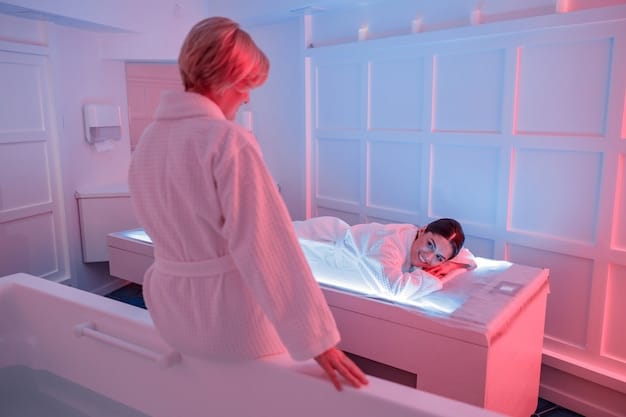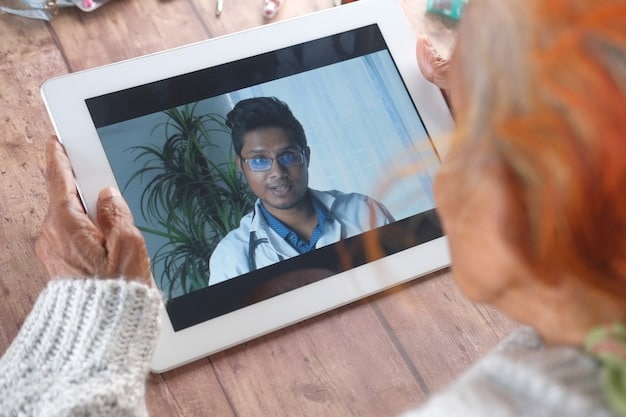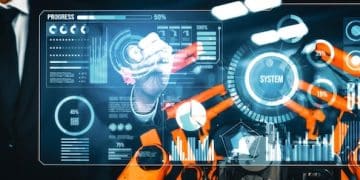The Future of Healthcare: Telemedicine & Remote Monitoring

The future of healthcare is rapidly evolving with telemedicine and remote patient monitoring (RPM) emerging as pivotal components, enabling more accessible, efficient, and personalized care delivery.
The landscape of healthcare is undergoing a significant transformation, driven by technological advancements. Among the most impactful changes are the rise of telemedicine and remote patient monitoring, which are poised to revolutionize how healthcare is delivered and accessed.
Understanding Telemedicine and its Impact
Telemedicine, at its core, involves providing healthcare services remotely, leveraging technology to bridge the gap between patients and providers. This encompasses a wide range of services, from virtual consultations to remote diagnostics, all aimed at improving access to care.
The impact of telemedicine is multi-faceted, touching upon various aspects of healthcare delivery. Not only does it offer convenience for patients, but it also enables providers to extend their reach and optimize their resources.
Benefits of Telemedicine
Telemedicine offers a plethora of advantages that contribute to its growing popularity and adoption. These benefits extend to patients, providers, and the healthcare system as a whole.
- Increased Access to Care: Telemedicine eliminates geographical barriers, allowing patients in remote or underserved areas to connect with specialists and receive timely care.
- Convenience and Time Savings: Virtual consultations save patients travel time and expenses, reducing the disruption to their daily lives.
- Improved Chronic Disease Management: Remote monitoring and virtual check-ins enable providers to closely monitor patients with chronic conditions, preventing complications and hospitalizations.
- Reduced Healthcare Costs: Telemedicine can lower healthcare costs by reducing the need for in-person visits and hospital readmissions.
Telemedicine is reshaping healthcare by making it more convenient, accessible, and cost-effective. By leveraging technology, it empowers both patients and providers to manage health more effectively. This increased convenience translates to better health outcomes and ultimately, a more efficient healthcare system.

The Rise of Remote Patient Monitoring (RPM)
Remote Patient Monitoring (RPM) is an innovative healthcare approach that utilizes technology to track and monitor a patient’s health data from a distance. This method involves the use of wearable devices, sensors, and other digital tools to collect vital signs, activity levels, and other relevant health information.
RPM allows healthcare providers to gain real-time insights into a patient’s condition without requiring them to be physically present at a clinic or hospital. This is particularly valuable for managing chronic conditions and ensuring timely interventions.
How RPM Works
RPM typically involves the use of wearable sensors that continuously track a patient’s vital signs, such as heart rate, blood pressure, and blood glucose levels. The data is then transmitted to a healthcare provider, who can monitor it for any signs of deterioration.
RPM systems also often include patient portals where individuals can view their own health data, communicate with their care team, and receive personalized guidance on managing their conditions.
By leveraging RPM, healthcare providers can proactively identify and address potential health issues, leading to better outcomes, reduced hospitalizations, and improved patient satisfaction. Furthermore, the data collected through RPM can be used to personalize treatment plans and provide more targeted interventions.
Telemedicine and RPM: A Synergistic Relationship
Telemedicine and Remote Patient Monitoring (RPM) are not mutually exclusive; rather, they complement each other in enhancing healthcare delivery. When combined, they offer a powerful approach to patient care with benefits that extend beyond what either could achieve alone.
The synergistic relationship between telemedicine and RPM is transforming healthcare by enabling more proactive, personalized, and efficient care delivery.
Improved Patient Engagement
Increased patient engagement is a crucial benefit of both telemedicine and RPM. By using these technologies, patients can take a more active role in managing their health.
- Remote monitoring can empower patients to stay more informed and proactive about their health.
- Telemedicine platforms offer a convenient way for patients to communicate with their healthcare providers and ask questions.
- By utilizing both telemedicine and RPM, patients can feel more connected to their healthcare team and more committed to adhering to their treatment plans.
This improved patient engagement helps foster a stronger sense of responsibility and collaboration in healthcare, leading to better health outcomes and a greater sense of well-being.

Challenges and Considerations for Telemedicine and RPM
While telemedicine and remote patient monitoring (RPM) offer numerous benefits, it’s essential to acknowledge and address the associated challenges and considerations to ensure their effective and ethical implementation.
Addressing these challenges is crucial for realizing the full potential of telemedicine and RPM and ensuring equitable access to quality healthcare for all.
Data Security and Privacy
Data security and patient privacy are paramount concerns in the realm of telemedicine and RPM. These systems rely on the collection, transmission, and storage of sensitive patient data, making them potential targets for cyberattacks and privacy breaches.
- Healthcare organizations must implement robust security measures, such as encryption, access controls, and regular security audits, to protect patient data.
- Patients need to be informed about the data security practices of telemedicine and RPM providers and be given control over their personal health information.
- Compliance with privacy regulations, such as HIPAA, is essential to maintain patient trust and ensure legal compliance.
By prioritizing data security and privacy, healthcare providers can mitigate risks and foster greater trust in these technologies.
The Role of Artificial Intelligence (AI) in Telemedicine and RPM
Artificial intelligence (AI) is poised to play a transformative role in telemedicine and remote patient monitoring (RPM), enhancing their capabilities and unlocking new possibilities for healthcare delivery.
AI can analyze vast amounts of data collected through RPM devices to identify patterns and predict potential health risks, enabling more proactive and personalized care.
AI-Powered Diagnostics
AI algorithms can analyze medical images, such as X-rays and MRIs, to detect diseases and abnormalities with greater accuracy and speed, improving diagnostic capabilities in telemedicine settings.
- AI-powered chatbots can provide patients with instant answers to their medical questions, triage symptoms, and schedule virtual appointments.
- AI can personalize treatment plans based on a patient’s unique health data and preferences, leading to more effective and targeted interventions.
- Healthcare providers must ensure that AI algorithms are used ethically and responsibly, with appropriate safeguards to prevent bias and ensure transparency.
The use of AI in healthcare creates more opportunities for efficiency and patient-centered care.
Future Trends and Innovations in Telemedicine and RPM
The future of telemedicine and remote patient monitoring (RPM) is bright, with ongoing innovations and emerging trends poised to transform healthcare delivery even further. Technology will allow even more integration of patient care in remote environments.
These future trends hold the potential to make healthcare more accessible, convenient, and personalized, ultimately leading to better health outcomes and improved patient experiences.
Personalized Medicine and RPM
Personalized medicine can be enhanced by the use of RPM. The combination of genomic data, lifestyle information, and real-time health data collected through RPM devices can enable more tailored treatment plans.
Personalized medicine is not only about genetics, but also about understanding how lifestyle and environment affects a patient’s specific needs, based on RPM insights.
- Remote monitoring devices can track a patient’s response to specific medications, allowing for more precise dosing and treatment adjustments.
- RPM data can be used to identify individuals at high risk of developing certain diseases, enabling early interventions and preventive measures.
This personalized approach to healthcare can lead to more effective treatments, reduced side effects, and improved patient outcomes. As technology advances, we will have more precise remote patient monitoring applications available.
| Key Point | Brief Description |
|---|---|
| 🩺 Telemedicine | Remote healthcare via tech, bridging access gaps. |
| 📊 RPM | Tracks patient health remotely, allowing for interventions. |
| 🔒 Data Security | Protects patient data through encryption and compliance. |
| 🤖 AI Role | Enhances diagnostics and personalized treatment. |
FAQ
▼
Telemedicine is healthcare services done remotely using technology. This includes video calls with doctors to monitoring health data.
▼
Remote Patient Monitoring (RPM) uses devices to track vital signs, which are then sent to doctors. This way, they can monitor at home.
▼
Telemedicine increases access to experts no matter where you are. It can lower costs by removing a need for physical office visits.
▼
Healthcare providers secure data with encryption and adhere to HIPAA. Always ask about security when choosing a service.
▼
AI analyzes healthcare data collected through telemedicine for any signs of illness. AI-powered apps enhance telemedicine services.
Conclusion
Telemedicine and remote patient monitoring are set to revolutionize healthcare by increasing access, efficiency, and personalization of care. Overcoming existing challenges and embracing future innovations will pave the way for a healthcare system that is more patient-centered, proactive, and effective.





